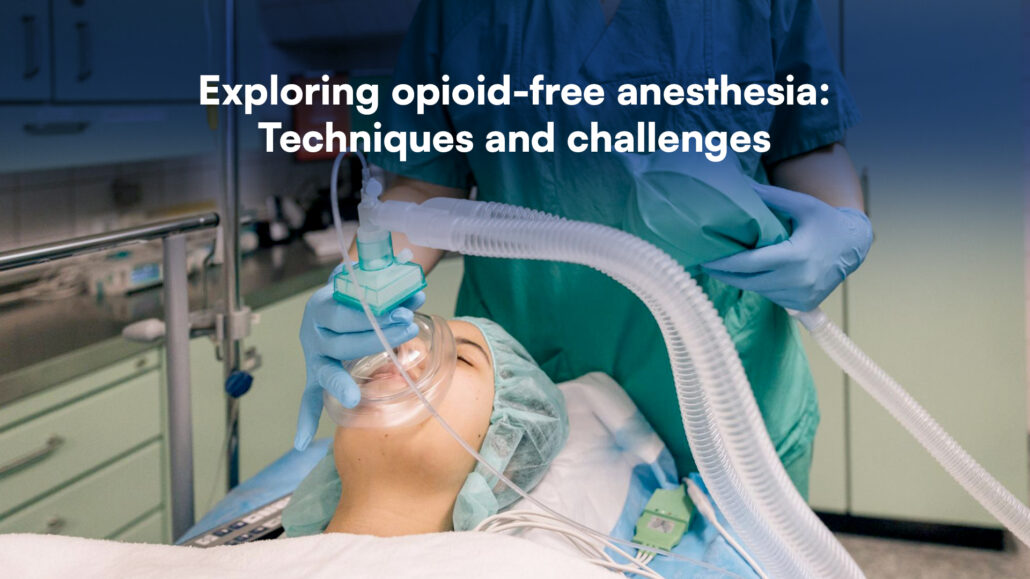
Opioid-Free General Anesthesia: Considerations, Techniques, and Limitations
In the ongoing efforts to manage pain effectively during surgery while minimizing the risks associated with opioid use, opioid-free anesthesia (OFA) has gained increasing attention. Traditionally, opioids have played a central role in perioperative care, providing strong analgesic effects during and after surgery. However, the risks associated with opioid use, such as addiction, respiratory depression, and opioid-related adverse events (ORADE), have led to the exploration of alternative strategies.
This study by Shanthanna et al. 2024 explores the rationale behind opioid-free general anesthesia, its potential benefits, and the limitations and challenges associated with its implementation.
The Role of Opioids in General Anesthesia
For decades, opioids have been a cornerstone of anesthesia due to their potent ability to manage nociceptive stimuli during surgery. The main functions of opioids in anesthesia include:
- Suppressing the autonomic nervous system’s response to surgical stress.
- Providing immobility and unconsciousness to maintain general anesthesia.
- Minimizing other anesthetic drugs, thus improving hemodynamic stability during surgery.
However, despite their benefits, opioids are associated with several adverse effects, particularly postoperative nausea and vomiting (PONV), sedation, and respiratory depression. Concerns about long-term opioid use and dependence have also driven the search for alternative methods that avoid opioids altogether.
What is Opioid-Free Anesthesia?
OFA is defined as the complete avoidance of opioids during the intraoperative period. Instead of opioids, a combination of non-opioid analgesics and anesthetic adjuncts are used to manage pain and control autonomic responses during surgery. This approach typically includes:
- Nonsteroidal anti-inflammatory drugs (NSAIDs) and acetaminophen.
- Local anesthetics such as lidocaine.
- Ketamine which blocks NMDA receptors and can provide analgesia at sub-anesthetic doses.
- Dexmedetomidine is an alpha-2 agonist with sedative and analgesic properties.
- Beta-blockers like esmolol reduce the body’s response to surgical stress.
- Magnesium sulfate can inhibit calcium channels and have analgesic effects.
Benefits of Opioid-Free Anesthesia
Advocates of OFA highlight several potential benefits, particularly the reduction of opioid-related side effects:
- Reduced Postoperative Nausea and Vomiting (PONV): Opioids are a major contributor to PONV,a common and distressing side effect of surgery. Studies have shown that OFA can reduce the incidence of PONV, especially when multimodal analgesia and appropriate antiemetics are used.
- Avoidance of Respiratory Depression: Opioids suppress respiratory function, which can be particularly risky during the perioperative period. By avoiding opioids, OFA aims to reduce this risk.
- Reduced Risk of Opioid Addiction and Long-Term Use: Concerns about the opioid epidemic have prompted efforts to minimize opioid exposure. OFA, when combined with a postoperative pain management plan, could potentially reduce the risk of long-term opioid use.
Techniques for Implementing Opioid-Free Anesthesia
The choice of drugs and techniques in OFA depends on the type of surgery and the patient’s specific needs. Common strategies include:
- Local and Regional Anesthesia: Local anesthetics like lidocaine and regional nerve blocks are used to manage pain at the surgical site. These techniques are particularly effective for limb, breast, and abdominal surgeries.
- Multimodal Analgesia: This approach combines different classes of analgesics to achieve adequate pain control without relying on opioids. NSAIDs, acetaminophen, and other adjuncts like ketamine and magnesium are used in combination to provide broad-spectrum analgesia.
- Sedative Agents: Dexmedetomidine, a sedative, and anxiolytic, is often used in OFA protocols for its ability to reduce the need for other anesthetics and provide analgesia. However, it can cause side effects such as bradycardia and hypotension.
Limitations and Concerns
While OFA offers certain advantages, it is not without challenges:
- Increased Complexity and Resource Use: OFA protocols often involve the use of multiple drugs administered through continuous infusions, which requires careful monitoring and resource allocation. This complexity may increase the cost of care and place additional demands on anesthesiologists.
- Narrow Therapeutic Range of Adjuncts: Many drugs used in OFA have a narrow therapeutic range, meaning that their effective dose is close to the dose that causes side effects. For example, ketamine, while effective at reducing opioid-induced hyperalgesia, can cause hallucinations and sympathetic stimulation at higher doses.
- Postoperative Pain Control: There is little evidence that OFA leads to better postoperative pain outcomes, and some studies suggest that patients may experience more pain once the intraoperative effects of adjuncts like dexmedetomidine or ketamine wear off.
- Increased Short- and Long-Term Pain: OFA may increase the risk of rebound pain after surgery. For example, patients undergoing shoulder surgery with interscalene blocks have been observed to have higher short-term opioid requirements if opioids are completely avoided during surgery.
- No Proven Reduction in Long-Term Opioid-Related Harms: While OFA may reduce opioid exposure during surgery, there is little evidence to suggest that it decreases the risk of chronic postoperative opioid use. The real challenge lies in managing postoperative pain without opioids, which is a key factor in determining long-term outcomes.
When Should Opioid-Free Anesthesia Be Considered?
OFA is not a one-size-fits-all solution. It is most appropriate for minimally invasive surgeries, short-duration procedures, or patients at high risk for opioid-related complications, such as those with a history of opioid use disorder, sleep apnea, or other respiratory issues. However, in more invasive surgeries where pain management is a major concern, complete opioid avoidance may lead to worse outcomes and increased pain.
Conclusion
Opioid-free anesthesia is an emerging strategy that can reduce the perioperative use of opioids and their associated side effects. However, it should not be seen as a universal solution. OFA may be beneficial in selected patient populations and specific types of surgeries, but it requires careful consideration and close monitoring and management of adjunct medications. For most surgeries, a balanced approach using multimodal analgesia with opioid-sparing techniques rather than complete avoidance may offer the best outcomes.
For more detailed information, refer to the full article in Current Opinion in Anesthesiology.
Shanthanna H, Joshi GP. Opioid-free general anesthesia: considerations, techniques, and limitations. Curr Opin Anaesthesiol. 2024;37(4):384-390.
Learn more about opioid-free anesthesia with the Regional Anesthesia Manual e-Course. Access this valuable resource today on the NYSORA LMS website!




